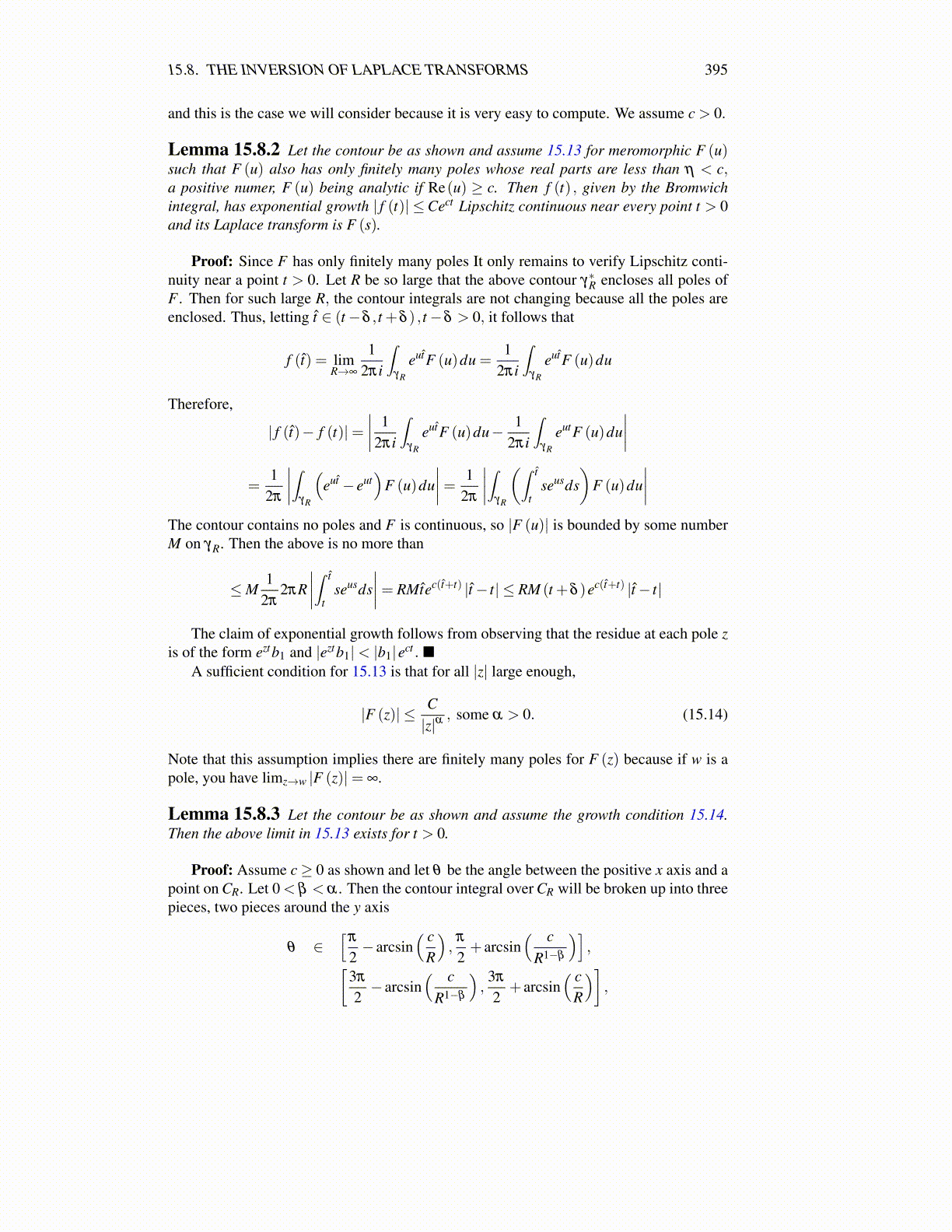
15.8. THE INVERSION OF LAPLACE TRANSFORMS 395
and this is the case we will consider because it is very easy to compute. We assume c > 0.
Lemma 15.8.2 Let the contour be as shown and assume 15.13 for meromorphic F (u)such that F (u) also has only finitely many poles whose real parts are less than η < c,a positive numer, F (u) being analytic if Re(u) ≥ c. Then f (t) , given by the Bromwichintegral, has exponential growth | f (t)| ≤Cect Lipschitz continuous near every point t > 0and its Laplace transform is F (s).
Proof: Since F has only finitely many poles It only remains to verify Lipschitz conti-nuity near a point t > 0. Let R be so large that the above contour γ∗R encloses all poles ofF . Then for such large R, the contour integrals are not changing because all the poles areenclosed. Thus, letting t̂ ∈ (t−δ , t +δ ) , t−δ > 0, it follows that
f (t̂) = limR→∞
12πi
∫γR
eut̂F (u)du =1
2πi
∫γR
eut̂F (u)du
Therefore,
| f (t̂)− f (t)|=∣∣∣∣ 12πi
∫γR
eut̂F (u)du− 12πi
∫γR
eutF (u)du∣∣∣∣
=1
2π
∣∣∣∣∫γR
(eut̂ − eut
)F (u)du
∣∣∣∣= 12π
∣∣∣∣∫γR
(∫ t̂
tseusds
)F (u)du
∣∣∣∣The contour contains no poles and F is continuous, so |F (u)| is bounded by some numberM on γR. Then the above is no more than
≤M1
2π2πR
∣∣∣∣∫ t̂
tseusds
∣∣∣∣= RMt̂ec(t̂+t) |t̂− t| ≤ RM (t +δ )ec(t̂+t) |t̂− t|
The claim of exponential growth follows from observing that the residue at each pole zis of the form eztb1 and |eztb1|< |b1|ect . ■
A sufficient condition for 15.13 is that for all |z| large enough,
|F (z)| ≤ C|z|α
, some α > 0. (15.14)
Note that this assumption implies there are finitely many poles for F (z) because if w is apole, you have limz→w |F (z)|= ∞.
Lemma 15.8.3 Let the contour be as shown and assume the growth condition 15.14.Then the above limit in 15.13 exists for t > 0.
Proof: Assume c≥ 0 as shown and let θ be the angle between the positive x axis and apoint on CR. Let 0 < β < α . Then the contour integral over CR will be broken up into threepieces, two pieces around the y axis
θ ∈[
π
2− arcsin
( cR
),
π
2+ arcsin
( cR1−β
)],[
3π
2− arcsin
( cR1−β
),
3π
2+ arcsin
( cR
)],